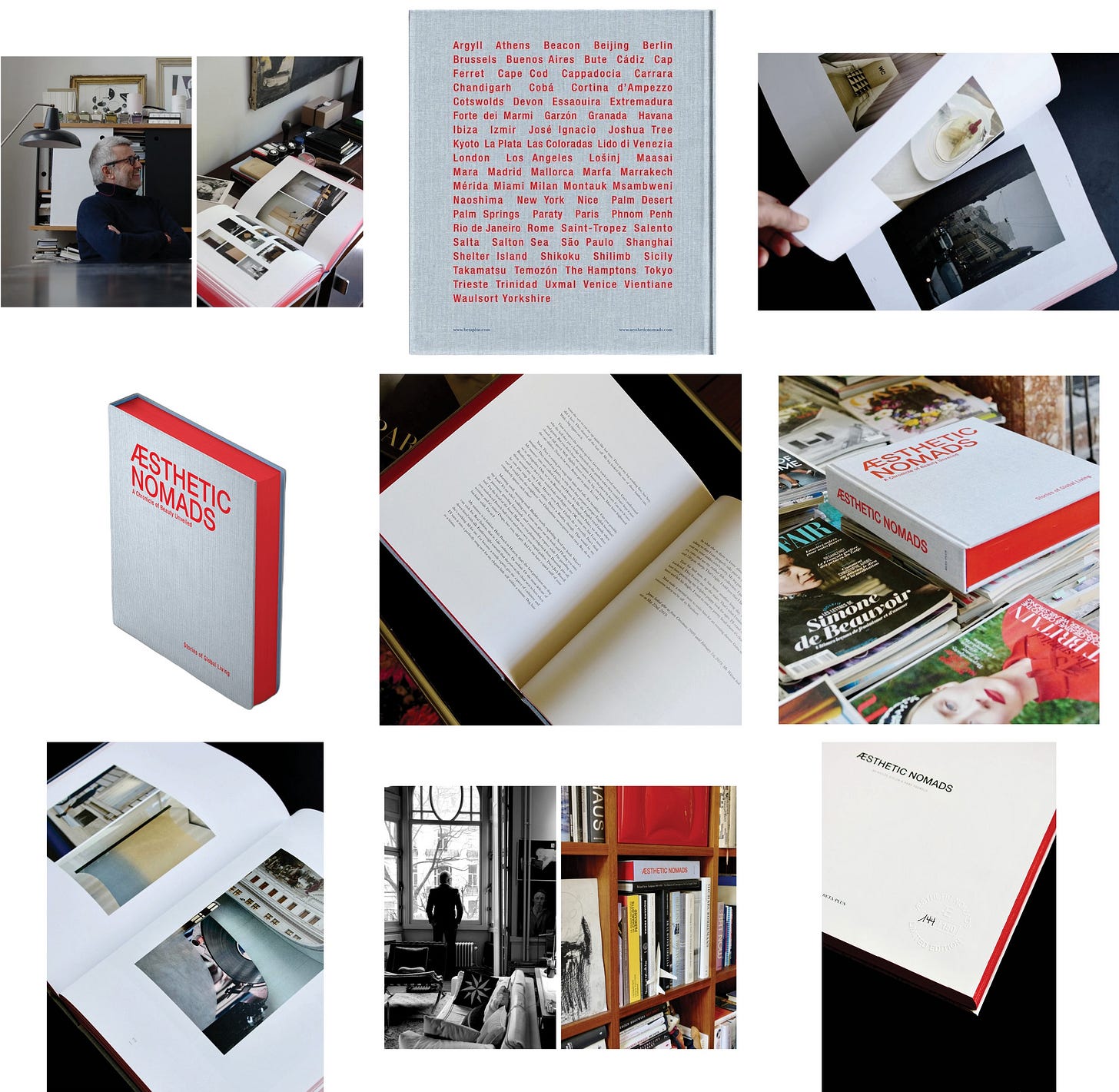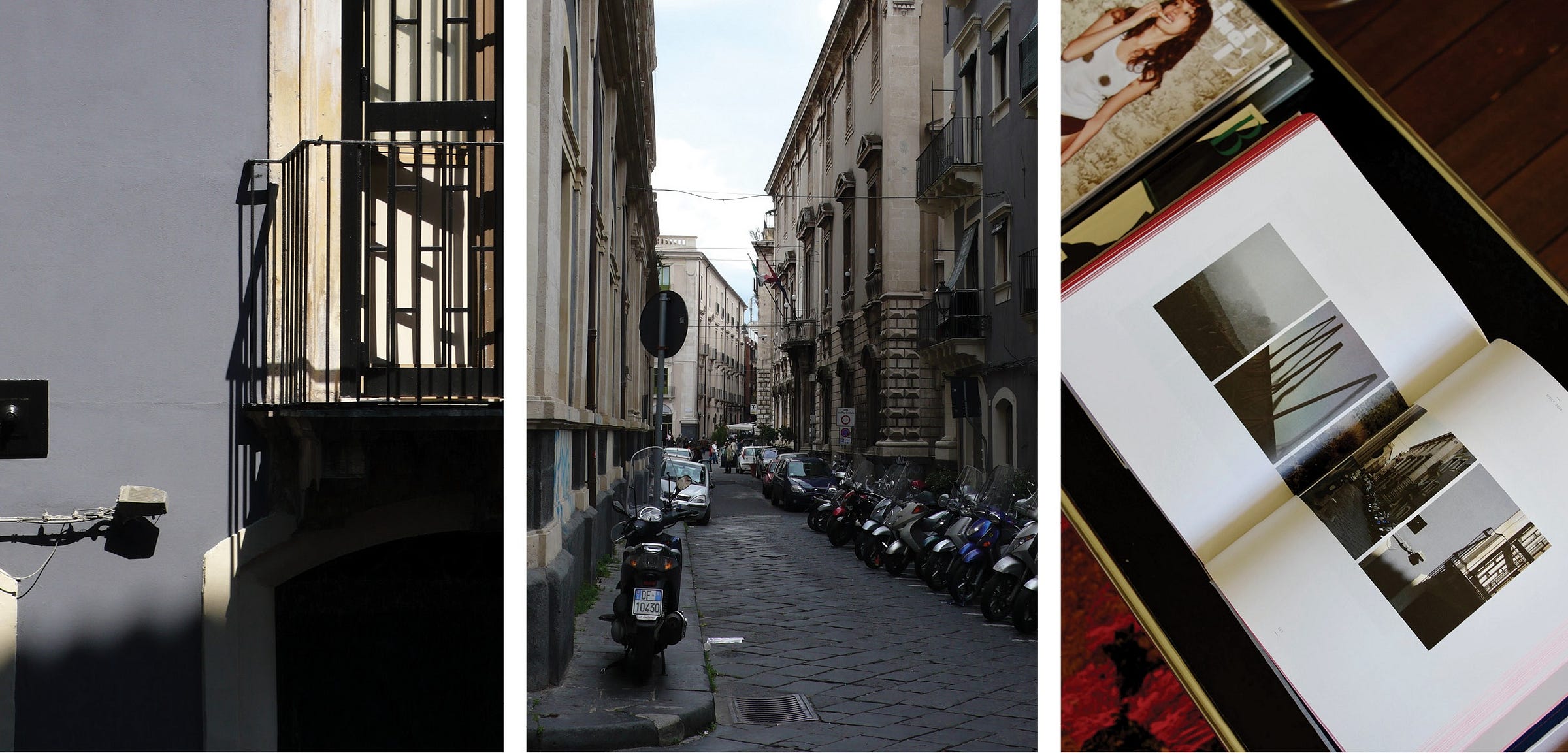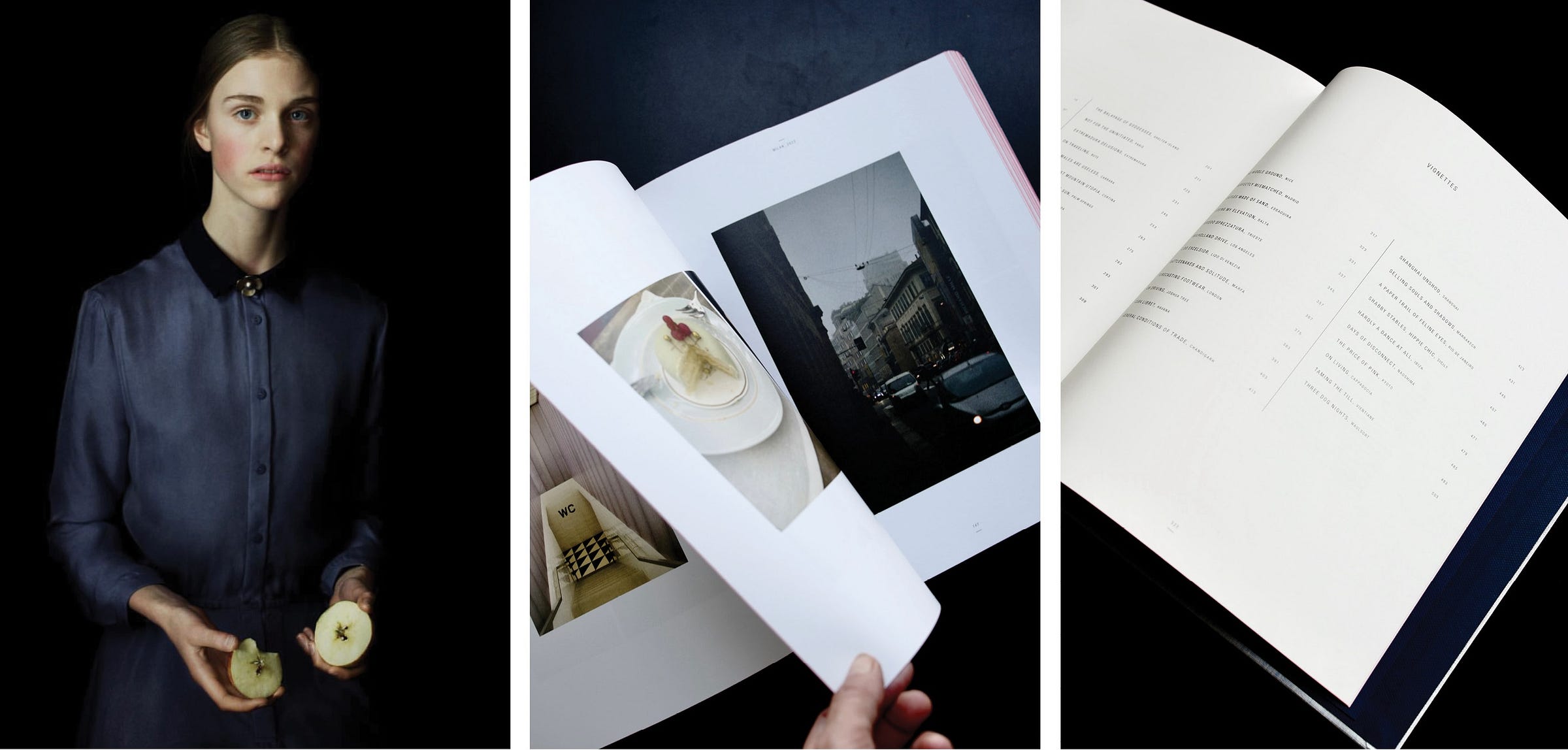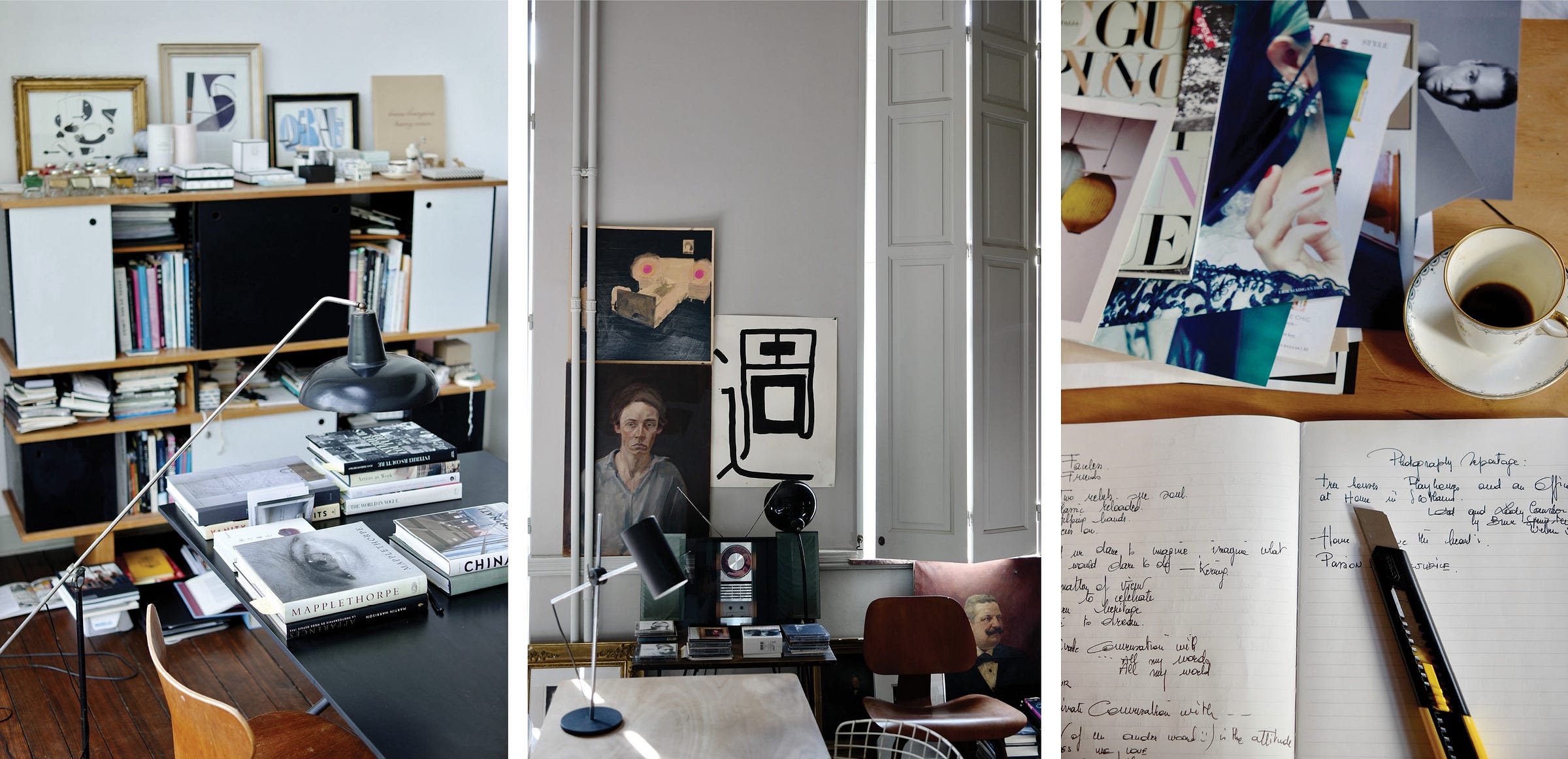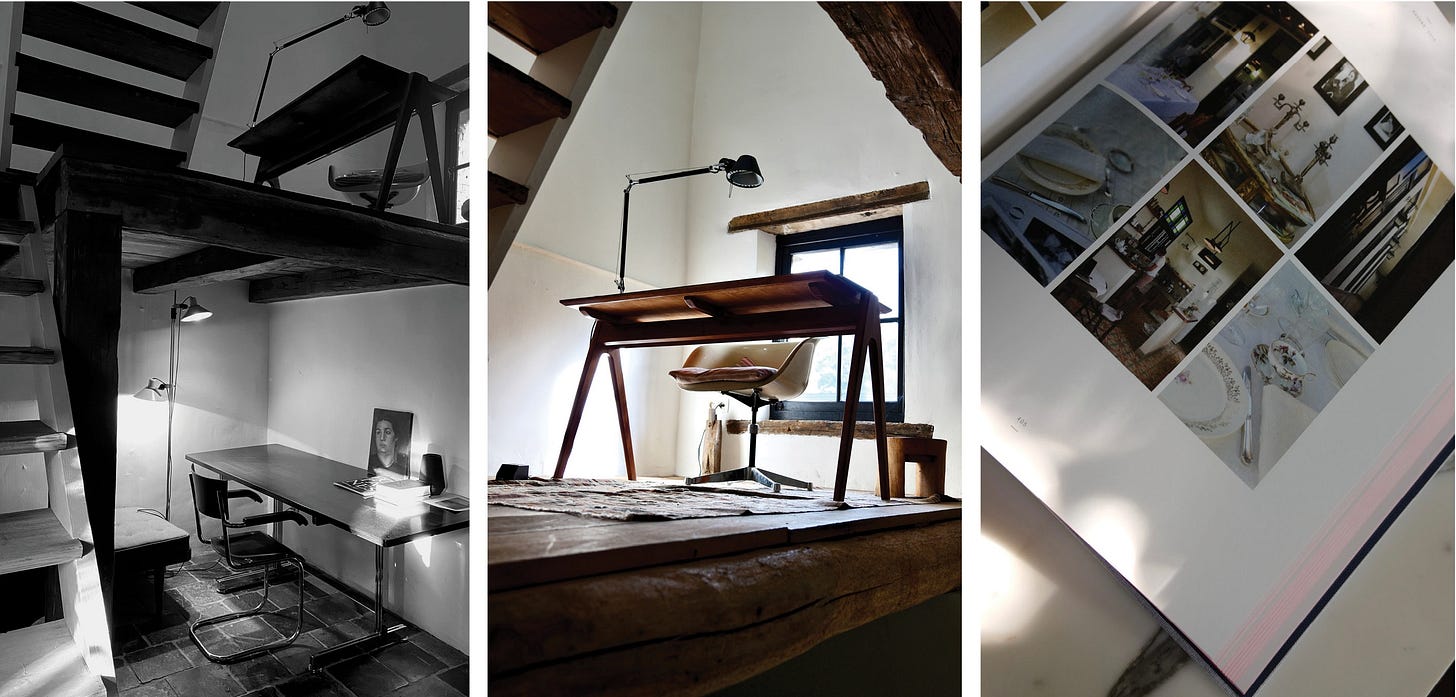A Chronicle of Beauty Unveiled
About Us, Our Lives as Nomads, and Our Book 'Æsthetic Nomads'.
Just over a year ago, we started working on our book ‘Aesthetic Nomads’. At the end of August, the open edition was delivered to selected bookstores around the world. This week, we received the limited edition—150 copies finished with red edging, numbered and signed by Reinhilde and myself.
528 pages, featuring unique locations around the world, are waiting for you to discover and enjoy. And get you inspired.
The following text is the introduction as published in Aesthetic Nomads.
Some people know what their lives will be like. From their earliest childhood, they want to become dentists, pilots, teachers, or lawyers. They devote their very existence to accomplishing just such an objective. We've never felt like that; we had no idea what we wanted, but we were sure that life for us would take place elsewhere. The irresistible appeal of the unknown—which, at that time, meant whatever lay beyond the limits of the rather provincial towns we grew up in—affected us both. We grasped at every opportunity to make this come about—soulmates long before we met.
We each conceived our escape plans from a different perspective. Reinhilde's was based on beauty, mine on language. But if you consider beauty to be the most universal of languages, maybe our strategies weren't so far apart after all. The fact is, we left our homes for universities and international careers. We never returned.
I was the youngest of three by 10 and 13 years—an accident, according to my sisters, but, in my opinion, the jewel in the crown that took a decade of polishing—introverted and quiet, a stutterer with a natural ability to find impromptu synonyms for words starting with p, t, and k. I expected the world to look like my brother-in-law's Desmond Bagley novels, which I devoured well before I should have. A six-week stay with a Tamil family on the outskirts of Colombo made me aware that reality was way more compelling than the plot of novels. I was 17 and hooked on whatever the world had to offer.
Reinhilde began her global journey as an au pair for a wealthy French family, a grand entrée into the world of sophistication, class, and elegance, with walks in Parc Monceau, shopping on Faubourg Saint Honoré, and summer couscous dinners for friends and family at the country home in Pont-Saint-Esprit. She, too, was 17 and just as fascinated by a world where beauty and art de vivre could thrive. Theirs was a world without its rougher edges.
These experiences shaped our perspective on life.
Our careers in fashion and business permitted us to travel the world, both professionally and privately. There were years when our combined travel schedules meant spending over 200 days abroad, mostly alone, often staying every night in a different city at a different hotel. We were nomads who got glimpses of cities through the windows of taxis and hotel rooms. Time with people we met and admired was too short. So we compared notes and kept a list of places that we wanted to visit again and people that we wanted to know better.
Our book is about these places and their people.

It's a visual chronicle of fragments that share one characteristic: beauty. Never the beauty that is conspicuous or mundane; let's leave that to Instagram and the majority of its influencers, or to the cookie-cutter homes and hotels you find on Airbnb and Booking. It is rarely about the beauty that screams for attention; you'll find that yourself.
It is about the beauty that lurks hidden, that is masked or shy, and that tries its best not to be noticed. It resides in minute details, in juxtapositions, in contrasts, or in combinations. Most often, it appears at second sight. Like the houses on the Garzón town square, squat and unadorned, at the precise moment when their washed-out walls reverberate in the late afternoon sun. Visit the restrooms at the Fondazione Prada, not because you need to go but because Rem Koolhaas turned a purely utilitarian space into the perfect minimalistic piece of art. That's what we think beauty is about.
This book is about time, or rather, timelessness.
What makes true beauty transcend time so effortlessly? A fifth-century BC sculpture of a horse at the Acropolis Museum in Athens is as exquisite as the Kapoors and the Ai Wei Weis that blew us away at the Venice Biennale. Why does the Quadrangle of the Nuns in Uxmal feel every bit as forward-thinking as Oscar Niemeyer's French Communist Party Headquarters in Paris? More than a thousand years apart, they fulfilled mostly the same functions. We cannot explain this through theories; this is not a dissertation. We can only share examples of what we have seen during our travels. It is universal. We found timeless beauty in form, in color, and in light everywhere around the world, without exception. And precisely because of the light, the moment would be fleeting if it weren't for the photograph itself. Talking about contradictions...
As a fashion designer, stylist, and creative director, Reinhilde has a well-trained eye for trends and hype. Don't look for them here. It's not about promoting destinations, restaurants, shops, or events. It's not part of some big-brand marketing campaign. It's a carefully curated selection from a personal database that contains a countless number of photos, taken by Reinhilde, over 30 or more years. You'll see an evolution. We changed over the years. Our teenage sons who joined us on our travels are adults now and travel with their partners. Our dogs—you'll get to know them; they accompany us everywhere—were pups, grew up, and died. Their offspring took their place. In all of this, we find the photographs taken then to be as captivating as the ones taken now.
This book is about the valuable things in life.
We rarely travel because of a destination. We mostly travel because of a house—a distinct place where we can stay and truly discover the area within range of our temporary home. We never would have chosen Joshua Tree as a destination if it weren't for Acido Dorado, the glass house that blends into the desert. We are not talking luxury; the sea wind blows through the wooden slats at Hatch House. The chalets in Borca de Cadore are barely insulated and turn freezing at night in winter. We're talking about uniqueness, authenticity, and creativity. Genuine places designed to meet the fundamental needs of wellbeing at the time they were built. They are getting rare.
Food is one of these basic needs. First on the list at every destination is finding local ingredients, cooking them, and eating at a beautifully set table. Some people take their own pillows when they travel; we take tablecloths, napkins, and silverware. Lobster pasta in Cape Cod, honey and bacon on peanut butter sandwiches in Miami, and Iberico Bellota ham in Extremadura simply deserve to be presented well.
That goes for restaurants, too. They are the places where local families go for their Sunday lunches. They have been around for decades, and they are always packed with regulars. You'll be vetted at the door and served by waiters who take pride in their profession. There will be white tablecloths and restaurant-branded service sets. It will be loud and unforgettable. It's their unrestrained hospitality that made our family feel like locals, too.
Then there's home—the places we always come back to: a 1906 light-filled artist atelier in Brussels, built for the painter Firmin Baes, and a tiny 1830 farmhouse in a quaint village called Waulsort. We live indoors in one and outdoors in the other. Both were built with a purpose and restored meticulously to keep them very much as they were designed, flaws and all.
Our Brussels home is still a hub for creativity and creation. We filled it over the years with a playful mixture of art, mid-century furniture, books, magazines, photos, and the artworks that our children created when they were young. It is by no means minimalist, but in a very personal way, every object that we have collected seems to find its place organically and begins to radiate inspiration.
Waulsort is where the weather sets our agenda, and the garden commands our activities. In contrast to the dominance of nature that envelops it, this home fits like a tight, warm glove. Only a 90-minute drive from Brussels, the countryside eradicates all traces of the city. You'd expect the two separate worlds to collide, but they don't because Reinhilde designed them to be restored as family homes first and foremost, similarly inviting and remarkably connected.
This book is also about happiness.
Each journey is a feast. We have always been passionate about the challenges of new environments, cultures, and customs. Being out of our comfort zone keeps us on our toes. Sometimes we struggle, but we always learn. With more availability and better technology, we can travel for longer periods at a time, working remotely. This makes us more dependent on the local population and economy—more residents than travelers.
We are not nostalgic, but by going through Reinhilde's photo collection and creating coherent and intriguing visual narratives, we relived the excitement of experiences that were once new. Every page illustrates her relentless search for all things unconventional and enchanting. There are photographs that say it all in one single image. And there are compositions that tell a story far stronger than a single image can convey. Light and color always play the leading roles: the washed-out pastels of Salento, the vibrancy of Yucatan, and the earthen somberness of Argyll and Bute in autumn provide the backdrops for her finds.
And for me, there's the extra thrill of going back to creative writing after a lifetime of writing business reports and commercial go-to-market strategies. Don't look for sophisticated essays. I didn't want to write a travel guide, either. You'll find 46 short texts, one vignette for every episode, with a personal narrative that explores and reflects on contexts that are somehow attached to the extraordinary places, moments, and people encountered over years of traveling. I tried to make them vivid and engaging. Adding a decent dose of humor and a pinch of absurdity threw me back to my days at university. Only the beer was missing.
But most importantly, there's the pride and joy of being able to share our work with an audience around the world, hoping that you'll see the same glimpses of the extraordinary, experience the same sense of harmony, and feel the same emotions as we did when the photos were taken. Let us know; nothing would be more rewarding.
Ours is a very personal view of reality. It is not a representation of the world as it is, or as media platforms impose upon us. Their business model needs banality or polarization to attract views and generate advertising revenue. We don't. It's how we see the world when we travel for longer periods of time with a very selective mindset, dedicating time to photograph and write. You may find this myopic and naive. True perhaps; but why place triteness on a pedestal yet again?
You may think that we are old-fashioned. I disagree entirely. If this is clearly not about fashion, how can it be "old"-fashioned? Our world is speeding up. Business cycles contract everywhere. Industries boom and crash in months. Art and music go viral in days. In no time, the next phenomenon will replace them.
We, too, live in this über-dynamic world.
150 copies of this publication have been signed by the authors and numbered 1/150 to 150/150 in a limited edition with color edging, exclusively available from this website.
https://www.aestheticnomads.com/purchase
Contributors:
Hans Pauwels, words - Reinhilde Gielen, photographs





